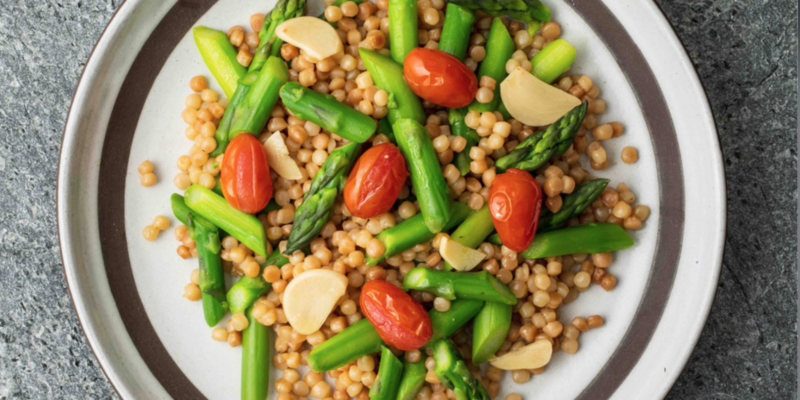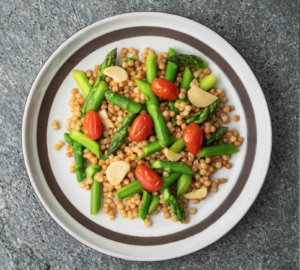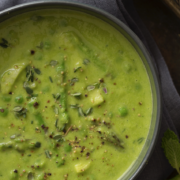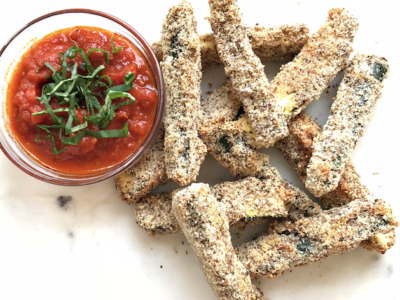There are more than a handful of dishes that are “traditional” for Rosh Hashanah, as there are for all Jewish holidays. For our New Year, it tends to be fish (particularly fish heads or gefilte fish), apples and honey, pomegranates (featuring their abundant, brightly colored seeds), carrots (particularly as tzimmes), and brisket (which we seem never to miss an opportunity to deploy). Most of these are Ashkenazi in origin. One of my favorites, Seven Vegetable Couscous, is not: its Sephardic.
Seven is a lucky number in many religions. That alone makes it a good and auspicious choice for the New Year’s table. Rosh Hashanah comes, of course, at the end of summer when many vegetables are at their peak. While produce like carrots, peppers, zucchini, butternut squash and turnips are common choices there is no single set that is requisite. The traditional, Moroccan version employs that country’s great culinary glory: couscous that is lovingly and longly prepared in a couscousier, a double-chambered food steamer used by the Berbers in North Africa to steam the couscous. Western versions of the dish tend to use instant couscous.
For my elegant, if loosely-inspired, version I take this Moroccan dish and plant it firmly in Israel using two vegetables and Israeli couscous. The latter may be Israeli, but it’s definitely not couscous. Couscous is ground semolina (crucially without being mixed with either egg or water) rubbed together with wet hands until tiny granules form and are then dried. Israeli couscous, on the other hand, is tiny balls (about the size of larger peppercorns) of true pasta made from both wheat flour and semolina then toasted.
Asparagus is a natural mate to Israeli couscous. Its brightness and astringency pairs well with the earthiness of the pasta. Tomato confit completes the picture by bringing sweetness, acidity and color to the dish.
Israeli Couscous with Asparagus and Tomato Confit
Serves 4
For the Vegetable Stock
1 ounce dried mushrooms (shiitake, oyster, porcini, or morel)
1 medium onion, roughly chopped
1 large carrot, roughly chopped
2 large (or 4 small) ribs celery, roughly chopped
3 leeks, green parts only (reserve the whites for another use), cleaned and roughly chopped
4 cloves garlic, crushed, peeled and crushed
2 large russet potatoes, peeled and roughly chopped
1 (4-inch) piece kombu
3 bay leaves
6 sprigs thyme
6 sprigs parsley
1 tablespoon whole black peppercorns
1 tablespoon whole white peppercorns
1 teaspoon fennel seeds
1 teaspoon coriander seeds
1 tablespoon salt (plus more as needed)
For the Tomato Confit
30 cherry tomatoes
4 cloves garlic, minced
2 cups extra-virgin olive oil
For the Israeli Couscous
1 tablespoon extra-virgin olive oil
1 cup Israeli couscous
Salt
2 to 3 cups Vegetable Stock
14 ounces slender asparagus spears, trimmed, cut diagonally into ¾-inch pieces (about 2 1/2 cups)
1/4 cup Tomato Confit
Directions
- Combine all the vegetable stock ingredients in a large stockpot and add water to cover, about 4 quarts. Bring to a boil over high heat, then reduce the heat to maintain a simmer and cook, uncovered, until the vegetables lose their texture and the stock takes on a soft but distinctly vegetal flavor, about 1 hour.
- Strain the stock into a heatproof bowl, discarding the solids. Taste the stock and add additional salt if required.
- Cool the stock, uncovered, to room temperature, then cover and transfer to the refrigerator until completely chilled. This sub-recipe will make more stock then you will need for this dish. Refrigerate for up to 5 days or freeze for up to 6 months.
- While the stock is simmering, make the tomato confit by combining the cherry tomatoes, garlic, and oil in a small saucepan.
- Place over medium heat and bring to a boil. Immediately reduce the heat to maintain a simmer and cook until the tomatoes just start to split, about 30 minutes.
- Transfer the tomatoes to a glass quart jar and refrigerate. Again, this will make more then you’ll need for this recipe. The tomato confit will keep in the refrigerator for up to 1 week.
- When the stock is done, heat the olive oil over medium heat in a medium heavy saucepan until shimmering.
- Add the Israeli couscous, season with salt, and cook until most of the couscous is golden brown, about 5 minutes.
- Add 2 cups of the vegetable stock, increase the heat to high, and bring to boil.
- Reduce the heat to medium-low, cover, and simmer until the stock is fully absorbed and the couscous is tender, about 10 minutes, adding more broth by the tablespoonful if the couscous is not yet tender.
- Meanwhile, bring 4 cups of salted water to a boil in a large saucepan.
- Prepare an ice bath.
- When the water boils, add the asparagus segments and blanch until their color brightens, 3 to 4 minutes depending on the thickness of the asparagus.
- Remove the asparagus from the water and shock in the ice bath to fix the color. Drain and pat with paper towels to remove excess water.
- Toss the asparagus with the couscous and divide into four bowls.
- Top each bowl with 1 tablespoon of the tomato confit and drizzle with as much as a teaspoon of oil from the confit (depending on how saucy the confit is).











Comments